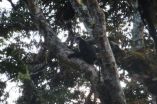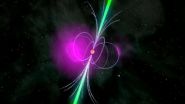(Press-News.org) Chinese researchers have published the first evidence that a population of the recently discovered snub-nosed monkey, Rhinopithecus Strykeri, live in China. Until now researchers have been unable to photograph the monkey, whose upturned nostrils are said to make it sneeze in the rain. The paper is published in the American Journal of Primatology.
The species was first discovered by a team led by Ngwe Lwin from the Myanmar Biodiversity and Nature Conservation Association and described by Dr Thomas Geissman in the American Journal of Primatology in October 2010. It was believed that the species was isolated to the Kachin State of north eastern Myanmar. However, this new discovery reveals the international range of this critically endangered species.
The new expedition, led by Yongcheng Long from the Nature Conservancy China Program, travelled to the Yunnan province of China after a forest guard, Liu Pu, took photos of a group of snub-nosed monkeys in a forest in near Pianma, in Yunann's Lushui County.
"The population of this species is hard to estimate, but based on our contacts with the monkey group both in October 2011 and in March 2012 we estimate the population to be less than 100 individuals," said Long. "However, while we now know the home range to be far greater than previously believed, we still do not yet know the true population number or the extent of their home range as the monkeys are shy and very hard to access."
In local dialects the species is called mey nwoah, 'monkey with an upturned face', although it was officially named 'Rhinopithecus Strykeri' in honour of Jon Stryker, President and Founder of the Arcus Foundation, which supported the initial project.
Local hunters claim the monkey is easy to find when it is raining because they often get rainwater in their upturned noses causing them to sneeze. However, long term observations did not show that they spend rainy days sitting with their heads tucked between their knees as the hunters also claim.
Thomas Geissmann, who led the taxonomic description, described the monkey as having almost entirely blackish fur with white fur only on ear tufts, chin beard and perineal area. It also has a relatively long tail, approximately 140% of its body size. The new photos confirm this description.
"After the discovery of the new species of Snub-nosed Monkey in Myanmar we conducted hunter interview surveys along the Chinese-Myanmar border which suggest at least one group in contiguous forest across the border in Yunnan. I contacted Long Yongchen my friend and colleague from the IUCN primate specialist group who followed and organised the first surveys that document the presence of the Myanmar 'snubby' in China," said Frank Momberg, Fauna & Flora International, Myanmar Program Director. "The discovery of Rhinepithecus strykeri in China gives a bit more hope for the species survival, however the population is still considered critically endangered, due to the high level of threats and very small population."
With a range crossing national borders efforts to conserve this endangered species will no longer by isolated to Myanmar. The country is currently experiencing political reform, which is expected to lead to economic and industrial development, which may impact natural areas. The researchers are calling for action from China, Myanmar and the international conservation community to protect the area's rich biodiversity.
"This monkey group was actually found in an area designated as a nature reserve 30 years ago and while local people have been hunting the species for ages, local managers knew nothing about it," concluded Long. "This highlights the need to improve wildlife management in China, as it is likely quite a few new species of plants and animals may be discovered in the border areas between China and Myanmar."
INFORMATION:
First photo evidence of snub-nosed monkey species in China
Researchers confirm that species is not restricted to Myanmar
2012-07-26
ELSE PRESS RELEASES FROM THIS DATE:
Study associates excess maternal iodine supplementation with congenital hypothyroidism in newborns
2012-07-26
Cincinnati, OH. July 26, 2012 – Congenital hypothyroidism is thyroid hormone deficiency at birth that, if left untreated, can lead to neurocognitive impairments in infants and children. Although the World Health Organization recommends 200-300 µg of iodine daily during pregnancy for normal fetal thyroid hormone production and neurocognitive development, the US Institute of Medicine considers 1,100 µg to be the safe upper limit for daily ingestion. A case series scheduled for publication in The Journal of Pediatrics describes three infants who developed congenital hypothyroidism ...
Teamwork against Benzene
2012-07-26
This press release is available in German.
Leipzig. The carcinogenic harmful substance benzene can seriously impact the soil and ground water following chemical accidents or at old industrial sites. Nevertheless, bacteria exist which can degrade this compound even in the absence of oxygen. Until now it was not clear which organisms take part in this process and how they work together. With modern analytical procedures scientists of the Helmholtz Centre for Environmental Research (UFZ) have succeeded for the first time in tracking the path of this harmful substance through ...
New stroke treatments becoming a reality
2012-07-26
Scientists led by the President of The University of Manchester have demonstrated a drug which can dramatically limit the amount of brain damage in stroke patients.
Professor Dame Nancy Rothwell, Professor Stuart Allan and their team have spent the last 20 years investigating how to reduce damage to the brain following a stroke.
They have been testing the effectiveness of the drug Anakinra (IL-1Ra), which is already used for rheumatoid arthritis in experimental studies of stroke.
This new study builds on previous research, although the big difference is that rats ...
Switching the state of matter
2012-07-26
Sixty years after the transistor began a technological revolution that transformed nearly every aspect of our daily lives, a new transistor brings innovations that may help to do so again. Developed at RIKEN, the device uses the electrostatic accumulation of electrical charge on the surface of a strongly-correlated material to trigger bulk switching of electronic state. Functional at room temperature and triggered by a potential of only 1 V, the switching mechanism provides a novel building block for ultra low power devices, non-volatile memory and optical switches based ...
A pulsar with a tremendous hiccup
2012-07-26
This press release is available in German.
Pulsars are superlative cosmic beacons. These compact neutron stars rotate about their axes many times per second, emitting radio waves and gamma radiation into space. Using ingenious data analysis methods, researchers from the Max Planck Institutes for Gravitational Physics and for Radio Astronomy, in an international collaboration, dug a very special gamma-ray pulsar out of data from the Fermi Gamma-ray Space Telescope. The pulsar J1838-0537 is radio-quiet, very young, and, during the observation period, experienced the strongest ...
New biomarker for common lung cancer predicts responses to chemotherapy
2012-07-26
Patients with the most common type of lung cancer are notoriously insensitive to chemotherapy drugs, including cisplatin. New findings related to the cellular pathways that regulate responses to cisplatin have now been published by Cell Press on July 26th in the journal Cell Reports. The findings reveal a potential biomarker that can be used to predict how these patients will respond to chemotherapy, as well as the patients' overall prognosis, paving the way for personalized treatment strategies.
Non-small cell lung cancer (NSCLC) is one of the leading causes of cancer-related ...
Methane measurements at low level flight
2012-07-26
A team of scientists from the Alfred Wegener Institute for Polar and Marine Research in the Helmholtz Association (AWI) and the GFZ German Research Centre for Geosciences has just completed an airborne measurement campaign that allowed for the first time to measure large-scale methane emissions from the extensive Arctic permafrost landscapes. The study area extended from Barrow, the northernmost settlement on the American mainland, across the entire North Slope of Alaska, to the Mackenzie Delta in the Northwest Territories of Canada. The airborne measurements (Airborne ...
Unprecedented accuracy in locating brain electrical activity with new device
2012-07-26
Researchers at Aalto University in Finland have developed the world's first device designed for mapping the human brain that combines whole-head magnetoencephalography (MEG) and magnetic resonance imaging (MRI) technology. MEG measures the electrical function and MRI visualizes the structure of the brain. The merging of these two technologies will produce unprecedented accuracy in locating brain electrical activity non-invasively.
We expect that the new technology will improve the accuracy of brain mapping of patients with epilepsy. It may also improve the diagnosis of ...
DNA damage in roofers due to PAH exposure – possible cancer link
2012-07-26
Roofers and road construction workers who use hot asphalt are exposed to high levels of polycyclic aromatic hydrocarbons (PAHs). A University of Colorado Cancer Center study published this week in the British Medical Journal Open shows that roofers have higher PAH blood-levels after a shift than before and that these high levels of PAHs are linked with increased rates of DNA damage, and potentially with higher cancer risk.
"We've known for some time that roofers and road workers have higher cancer rates than the general population, but we also know roofers have a higher ...
Deadly E. coli strain decoded
2012-07-26
EAST LANSING, Mich. — The secret to the deadly 2011 E. coli outbreak in Germany has been decoded, thanks to research conducted at Michigan State University.
The deadliest E. coli outbreak ever, which caused 54 deaths and sickened more than 3,800 people, was traced to a particularly virulent strain that researchers had never seen in an outbreak before. In the current issue of the academic journal PLoS ONE, a team of researchers led by Shannon Manning, MSU molecular biologist and epidemiologist, suggests a way to potentially tame the killer bacteria.
The strain, E. coli ...
LAST 30 PRESS RELEASES:
Numbers in our sights affect how we perceive space
SIMJ announces global collaborative book project in commemoration of its 75th anniversary
Air pollution exposure and birth weight
Obstructive sleep apnea risk and mental health conditions among older adults
How talking slows eye movements behind the wheel
The Ceramic Society of Japan’s Oxoate Ceramics Research Association launches new international book project
Heart-brain connection: international study reveals the role of the vagus nerve in keeping the heart young
Researchers identify Rb1 as a predictive biomarker for a new therapeutic strategy in some breast cancers
Survey reveals ethical gaps slowing AI adoption in pediatric surgery
Stimulant ADHD medications work differently than thought
AI overestimates how smart people are, according to HSE economists
HSE researchers create genome-wide map of quadruplexes
Scientists boost cell "powerhouses" to burn more calories
Automatic label checking: The missing step in making reliable medical AI
Low daily alcohol intake linked to 50% heightened mouth cancer risk in India
American Meteorological Society announces Rick Spinrad as 2026 President-Elect
Biomass-based carbon capture spotlighted in newly released global climate webinar recording
Illuminating invisible nano pollutants: advanced bioimaging tracks the full journey of emerging nanoscale contaminants in living systems
How does age affect recovery from spinal cord injury?
Novel AI tool offers prognosis for patients with head and neck cancer
Fathers’ microplastic exposure tied to their children’s metabolic problems
Research validates laboratory model for studying high-grade serous ovarian cancer
SIR 2026 delivers transformative breakthroughs in minimally invasive medicine to improve patient care
Stem Cell Reports most downloaded papers of 2025 highlight the breadth and impact of stem cell research
Oxford-led study estimates NHS spends around 3% of its primary and secondary care budget on the health impacts of heat and cold in England
A researcher’s long quest leads to a smart composite breakthrough
Urban wild bees act as “microbial sensors” of city health.
New study finds where you live affects recovery after a hip fracture
Forecasting the impact of fully automated vehicle adoption on US road traffic injuries
Alcohol-related hospitalizations from 2016 to 2022
[Press-News.org] First photo evidence of snub-nosed monkey species in ChinaResearchers confirm that species is not restricted to Myanmar




